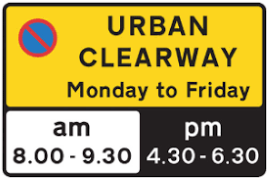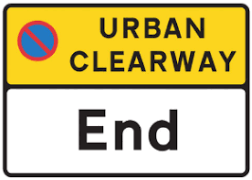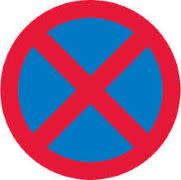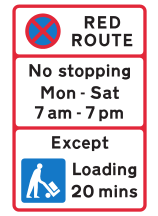What does an Urban Clearway sign mean?
Urban Clearway road signs are usually found in built-up areas. At the bottom of the sign, you’ll see some times listed. The Urban Clearway sign is there to tell you that you’re not allowed to stop your vehicle on the road or at the side of the road during these times unless you’re picking up or dropping off passengers.
The Urban Clearway road sign won’t be accompanied by any road markings. Instead, you’ll usually see Urban Clearway signs at regular intervals along the clearway, and then a sign that says ‘end’ once you’ve reached the end.


Can you park in an Urban Clearway?
You can park in an Urban Clearway, but not between the hours listed on the road sign. Usually, the times listed on an Urban Clearway sign will be rush hour. This allows traffic to flow freely along the road during peak times but means people can still park there during quiet periods and overnight.
Bear in mind that outside the times listed, it’s not a given that you’ll be able to park on the urban clearway for free. You may have to pay and display.
If you park in a clearway between the times forbidden, you’ll be breaking contravention code 46C - this includes blue badge holders and vehicles stopped for loading or unloading - and you’re likely to be landed with a fine. But this information isn't just handy to keep you inline with the law. It's also something that could crop up on your theory test, so make sure you're confident with Urban Clearway restrictions!
What are clearway restrictions?
Clearway restrictions depend on the type of sign that’s displayed. An Urban Clearway is only one kind of clearway road you might find.
Another common type is a 24-hour clearway. The 24-hour clearway sign is more commonly referred to as a ‘No Stopping’ sign. This features a blue circle with a red cross:

While you can stop and park outside of the times mentioned on an Urban Clearway sign, you can’t stop or park at all if you see a No Stopping sign that doesn’t include any times.
When you see one of these signs, it will apply to the main carriageway of the road it’s placed on, meaning that a vehicle can stop in a designated parking bay or on the verge if this doesn’t cause an obstruction to the main carriageway.
24-hour clearways are also sometimes referred to as rural clearways, as the idea was that these would mostly be applied to rural roads. However, many urban roads without direct frontages also make use of the 24-hour clearway sign.
A red route is another kind of clearway, which we’ll explore below.
What’s the difference between a red route and an Urban Clearway?
You can find red routes in London, Leeds and the West Midlands. These are always major roads.
Similarly to Urban Clearways, red route clearways are signposted and there are no road markings (although on red route clearways you’ll find red lines on the road at junctions). On a red route clearway, stopping is only permitted in laybys.
However, you’ll also find red routes that have red lines along the sides of the road:
- When there are double red lines, it means that vehicles are forbidden from stopping at any time of the day on all days.
- When there’s only a single red line, this means the regulations only apply during certain times.
Like with Urban Clearways, the times during which you’re not permitted to stop will be displayed on nearby signs like this one, or at the beginning of the zone:

Red routes also differ from Urban Clearways in that they don’t permit vehicles to stop to drop off or pick up passengers when the restriction is in place (unless it’s a taxi or a blue badge holder).